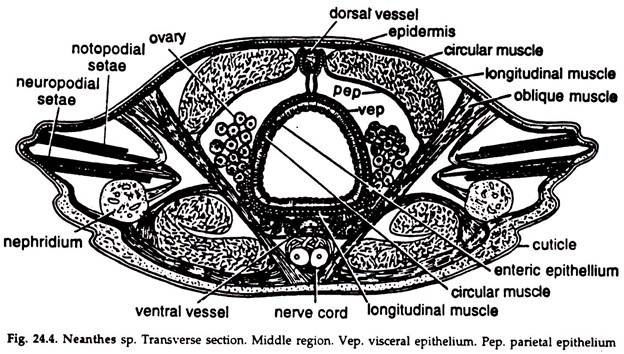In this article we will discuss about the anatomy of neanthes (sandworm), explained with the help of a suitable diagram.
1. The outermost layer is a thin, porous cuticle secreted by the underlying epidermis. Two intersecting systems of fine lines are present in the cuticle (Fig. 24.4).
2. The epidermis is a single layer of cells containing different types of numerous unicellular glands and plexuses of blood vessels on the dorsal surface. It is thick ventrally and thin dorsally.
ADVERTISEMENTS:
3. Dermis absent.
4. Two layers of muscles are present.
The outer circular muscular layer is a continuous one. The inner longitudinal muscular layer consists of four bundles of fibres, two dorsolateral and two ventrolateral.
5. Certain muscles run across the body wall obliquely and others run from dorsal to the ventral body wall.
ADVERTISEMENTS:
6. Parietal layer. A single layer of flat cells forms the innermost layer of the body wall lining the coelomic cavity.
7. A distinct coelom is present. One dorsal, one ventral, one sub neural vessel and one ventral nerve cord are present in the coelom. Coelom is divided into a number of compartments.
8. A Para podium is present on each lateral side. A Para podium consists of one dorsal lobe or notopodium and a ventral lobe or neuropodium with their bundles of setae.
9. The gut wall consists of:
ADVERTISEMENTS:
a. A visceral layer of coelomic epithelium.
b. Two layers of muscles—outer longitudinal and inner circular.
c. Enteric epithelium consists of a single layer of cells, some of which are glandular and others are absorptive.
